
by
Matt,
Paul,
KJF
February/14/2008
from
CooperativeResearch Website
This is a news item pertaining to the Complete
911 Timeline investigative project, one of several grassroots investigations
being hosted on the History Commons website.
The data published as part of this investigation
has been collected, organized, and published by members of the public who
are registered users of this website.
Latest Findings Raise New
Questions about Hijackers and Suggest Incomplete Investigation
A contributor to the History Commons has obtained a 298-page document
entitled Hijackers Timeline (Redacted) from the FBI, subsequent to a
Freedom
of Information Act request. The document was a major source of information
for the 9/11 Commission’s final report. Though the commission cited the
timeline 52 times in its report, it failed to include some of the document’s
most important material.
The printed document is dated November 14, 2003, but appears to have been
compiled in mid-October 2001 (the most recent date mentioned in it is
October 22, 2001), when the FBI was just starting to understand the
backgrounds of the hijackers, and it contains almost no information from the
CIA, NSA, or other agencies.
This raises questions as to why the 9/11
Commission relied so heavily on such an early draft for their information
about the hijackers.
Specific new information:
-
New evidence suggests that some of the
hijackers were assisted by employees of the Saudi government. It has
previously been reported that Omar al-Bayoumi, a Saudi who was paid by
the Saudi government despite not doing any work, assisted hijackers
Khalid Almihdhar and Nawaf Alhazmi when they first moved to the US.
The
FBI timeline shows that when these two hijackers moved into their first
San Diego apartment, they indicated that they had been living with Bayoumi in the apartment next door for the previous two weeks. In fact,
they had been with him in that apartment since January 15, 2000, the
very day they first flew into the US, arriving in Los Angeles.
The
timeline also reveals that hijacker Hani Hanjour was seen in Bayoumi’s
apartment.
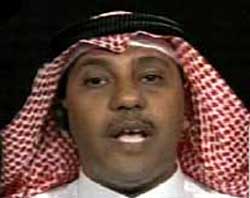
Omar al-Bayoumi.
[Source: Saudi Government
via Al Arabiya]
-
The new book
The Commission by New York
Times reporter Philip Shenon published last week further reveals that
Bayoumi had close ties to Fahad al-Thumairy, a radical imam working in
the Saudi consulate in Los Angeles. For instance, Bayoumi frequently
called al-Thumairy while living next door to the two hijackers, and also
frequently called the Saudi embassy in Washington,
D.C.
The book also reveals that the 9/11 Commission was aware
of “explosive” revelations about the ties between Bayoumi, Thumairy, and
the two hijackers, but the commission’s final report omitted “virtually
all of the most serious allegations against the Saudis,” due to
diplomatic considerations. Now, thanks to this FBI timeline, we are
discovering more of this suppressed evidence relating to Saudi Arabia.
-
Security camera footage obtained by the FBI
after 9/11 indicated that Khalid Almihdhar and possibly Salem Alhazmi
cased Dulles Airport in Washington, D.C., the evening before 9/11. This
fits the account of a
security guard , related in Unsafe at
Any Altitude by Joe and Susan Trento, who independently claimed to have
seen two hijackers, Salem’s brother Nawaf and Marwan Alshehhi, casing
Dulles Airport the night before 9/11.
This guard claims the two
hijackers were part of a group of five men, three of whom were dressed
in United Airlines ramp worker uniforms, that behaved suspiciously.
Despite a lawsuit by 9/11 victims’ relatives against United Airlines and
others for negligence, the US government has never revealed the
existence of this video footage which might support claims that the
hijackers had inside help.
-
Hijackers Marwan Alshehhi and Hamza Alghamdi
purchased hundreds of dollars of “pornographic video and sex toys” in
Florida. They spent $252 on video and toys in early July 2001, and then
another $183 later that month. Furthermore, Satam Al Suqami likely paid
for a sex escort in Boston on September 7, 2001. Alshehhi was also
recognized by six dancers at Cheetah’s, a nightclub in Pompano Beach,
Florida.
This fits in with
other evidence of the hijackers
drinking
alcohol, paying for lap dancers,
watching pornographic videos, etc…—hardly the expected behavior of
religious radicals.
-
On March 20, 2000, either Khalid Almihdhar
or Nawaf Alhazmi used a phone registered to Alhazmi to make a call from
San Diego to an
al-Qaeda communications hub in Sana’a, Yemen,
run by
Almihdhar’s father-in-law. The call
lasted 16 minutes. According to the 9/11 Congressional Inquiry, the call
was intercepted by the NSA, which had been intercepting Alhazmi and
Almihdhar’s
calls for over a year, but
the FBI was not informed of the
hijackers’ presence in the US.
The call is only briefly mentioned as a
family phone call by the 9/11 Commission in a endnote, and it is not
mentioned that the call was monitored.
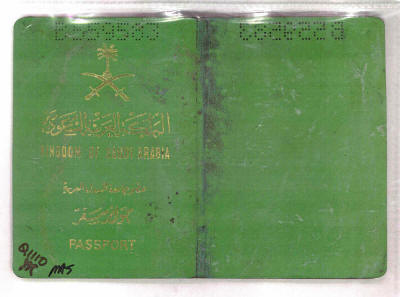 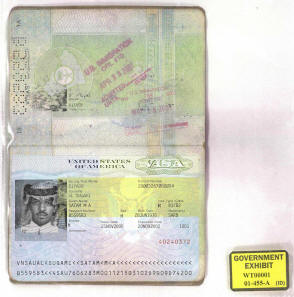
The passport of hijacker
Satam Al Suqami
from websites
here and
here
Satam Al Suqami ‘s
remarkably undamaged passport, marked and wrapped in plastic.
[Source: FBI]
-
When hijacker Satam
Al Suqami’s passport was recovered on 9/11 on the street near the
World Trade Center, it was “soaked in jet fuel.”
-
Hijacker Hamza Alghamdi booked several
flights after 9/11. He booked a continuation from Los Angeles to San
Francisco later on the day of the attacks. Then, on September 20, he
planned to fly from Rome to Casablanca, to Riyadh, to Damman, Saudi
Arabia.
-
It has been widely assumed that the
hijackers did everything using their real names, or aliases close to
their real names. But a still-classified CIA report found that the
hijackers used
364 aliases and name variants. The
FBI’s timeline discloses what some of them were.
For example, Hani
Hanjour and Ahmed Alghamdi rented a New Jersey apartment using the names
Hany Saleh and Ahmed Saleh.
Fayez Ahmed Banihammad used the aliases Abu
Dhabi Banihammad and Fayey Rashid Ahmed. Mohamed Atta frequently liked
to use variants of the name El Sayed, for instance calling himself Awaid
Elsayed and even Hamburg Elsayed. And when Majed Moqed flew into the US
on May 2, 2001, the name Mashaanmoged Mayed was on the flight manifest.
This suggests that some travel and actions of the hijackers could have
been missed when they used unlikely aliases.
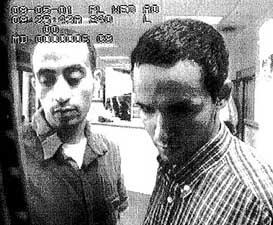
An ATM video still of
Hani Hanjour (left) and Majed Moqed (right).
[Source: FBI]
-
There has been very little video footage
released of the hijackers. So far, the only known footage has been two
video stills of Hani Hanjour and Majed Moqed using an ATM machine, one
still each of Waleed Alshehri and Satam Al Suqami, several stills of
Mohamed Atta and Abdulaziz Alomari in Portland
the night before 9/11, and a few more
stills and footage of several hijackers in airports on the
morning of
9/11.
But the FBI’s timeline reveals
there is more video footage that has never even been publicly hinted at:
-
Mohamed Atta used an ATM in Palm Beach, Florida, on July 19, 2001.
-
Salem Alhazmi and Ahmed Alghamdi used an ATM in Alexandria, Virginia, on
August 2.
-
Hanjour and Mojed used a Kinko’s for half an hour in College
Park, Maryland, on August 10.
-
Moqed and Nawaf Alhazmi shopped at an
Exxon gas station in Joppa, Maryland, on August 28.
-
Waleed and Wail
Alshehri wandered around a Target store in Fort Lauderdale, Florida, on
September 4.
-
Atta and Abdulaziz Alomari were in a Florida bank lobby on
September 4, and the audio of Atta calling Saudi Arabia was even
recorded in the process.
-
Fayez Ahmed Banihammad used an ATM on September
7 in Deerfield Beach, Florida.
-
Salem Alhazmi was at the Falls Church DMV
on September 7.
-
Low quality surveillance video at the Milner Hotel in
Boston showed Alshehhi and possibly Mohand Alshehri on multiple
occasions in the days just before 9/11.
-
Ziad Jarrah and possibly Saeed
Alghamdi were videotaped using a Kinko’s for about an hour near Newark
on September 10.
-
Some credit cards used by the hijackers were
still used in the US after 9/11. For instance, a credit card jointly
owned by Mohamed Atta and Marwan Alshehhi was used twice on September
15. This helps confirm news reports from late 2001 that hijacker
credit cards were
used on the East Coast as late as early October
2001.
At the time, a government official said that while some
of the cards might have been stolen, “We believe there are additional
people out there” who helped the hijackers.
-
The FBI timeline shows other intriguing
hints that the hijackers had associates in the US. For instance, on
September 8, 2001, hijackers Majed Moqed and Hani Hanjour went to a bank
with an unnamed Middle Eastern male. This man presented a Pennsylvania
driver’s license for identification, but none of the 9/11 hijackers have
been reported to have a driver’s license from that state.
There is also
a highly redacted section hinting that a woman in Laurel, Maryland, was
helping Middle Eastern men and may have had links to hijackers Mohamed Atta and Ziad Jarrah.
-
Around 10:00 a.m. on the morning of 9/11, a
housekeeper at the Park Inn in Boston went to clean the room that
hijackers Wail and Waleed Alshehri used the night before. She was
confronted by a foreign male who told her that someone was still
sleeping in the room and that she should come back around 1:00 p.m.
The
FBI was obviously puzzled by this, as the FBI’s timeline entry for this
event ends with five question marks.
-
It has previously been reported that shortly
before 9/11, hijackers Nawaf Alhamzi and Khalid Almihdhar
left a bag at a mosque in Laurel,
Maryland, with a note attached to it saying, “Gift for the brothers.”
The FBI’s timeline identifies this mosque as the Ayah Islamic Center.
But the only contents mentioned in the bag were pilot log books,
receipts, and other evidence documenting the brief flight training that
Alhazmi and Almihdhar underwent in San Diego in early 2000.
It is
unclear why they would have kept the receipts, some mentioning their
names, for over a year and then left them at a mosque to be found. After
9/11, a former high-level
intelligence official told journalist Seymour
Hersh that “Whatever trail was left [by the hijackers]
was left deliberately—for the FBI to chase.”
-
On June 11, 2001, hijackers Saeed Alghamdi,
Ahmed Alnami, Marwan Alshehhi, and Mohamed Atta checked in to the Deluxe
Inn, in Dania, Florida. The manager of the hotel later identified Saeed
Alghamdi as having been there at the time with the others. However,
travel records indicate Alghamdi did not arrive in the US until June 27.
Other previously released evidence has suggested that many other
hijackers
were in the US before they officially arrived.
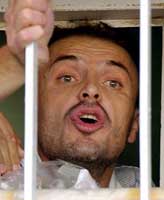
Luai Sakra imprisoned in
Turkey.
[Source: Reuters]
-
Several months ago, the London Times
reported on an al-Qaeda leader imprisoned in Turkey named Luai Sakra.
Sakra claims to have
trained six of the hijackers in Turkey,
including Satam Al Suqami. The FBI’s timeline supports his account,
because Al Suqami’s passport record indicates he spent much of his time
between late September 2000 and early April 2001 in Turkey.
Furthermore, Sakra claimed that Al Suqami was one of the hijacker leaders, and not
just another “muscle” hijacker as US investigators have alleged. The
FBI’s timeline supports this, because it shows that Al Suqami was
frequently on the move from 1998 onwards, flying to Syria, Jordan, Saudi
Arabia, Egypt, Bahrain, Oman, Qatar, United Arab Emirates, Iran,
Malaysia, as well as Turkey, and he travelled to most of these countries
more than once.
This is particularly important because contributors to
the History Commons have put together evidence suggesting that Sakra was
a CIA asset before 9/11, which would suggest that Al Suqami and other
hijackers were actually
trained by a
CIA asset.
-
When Ahmed Alghamdi arrived in the US from
London on May 5, 2001, an immigration inspector apparently noted that
Alghamdi commented to him that the media was distorting the facts about
Osama bin Laden and that bin Laden was a good Muslim. Alghamdi also
indicated that he was travelling with more than $10,000 worth of
currency.
Shortly after 9/11, the New York Times, Washington Post, and
other newspapers reported that by the spring of 2001,
US customs was investigating Alghamdi and two
other future 9/11 hijackers for their connections to known
al-Qaeda operatives.
One British newspaper even noted that Alghamdi
should have been “instantly ‘red-flagged’ by British intelligence” as he
passed through London on his way to the US because of a
warning about his links to al-Qaeda. It
has not been explained how Alghamdi was able to pass through British and
US customs, even as he was openly praising bin Laden.
-
Hijacker Nawaf Alhazmi was mugged outside of
his apartment in Alexandria, Virginia, by an “unknown black male” on May
1, 2001. He filed a police report about this and gave his correct name
and address. In August 2001, Alhazmi and Khalid Almihdhar were
watchlisted by the CIA, and an FBI
investigator began
looking for them in the US.
But, as one
news report later noted, the investigator “never performed one of the
most basic tasks of a police manhunt. He never ran Almihdhar or Alhazmi
through the NCIC computer,” a widely used police database that should
have listed this mugging, as well as a
speeding ticket Alhazmi had received
the month before.
-
On August 26, 2001, Nawaf Alhazmi’s car was
queried by police in Totowa, New Jersey, just a few miles from where he
was
living in Paterson. Police took down
details of his rental car and put all the information in the NCIC
database. On August 29, with Alhazmi still living in Paterson, an FBI
agent was assigned to look for him. But as mentioned above, he didn’t
search the NCIC database.
On September 2, this agent did
search a national motor vehicle database,
and this, the mugging, and other encounters Alhazmi had with police
should have shown up there as well, but for some inexplicable reason the
agent still did not discover that Alhazmi was in the US.
-
Hijacker Abdulaziz Alomari lost his plane
ticket just before 9/11. He reported it lost on September 8, and picked
a replacement ticket up from the American Airlines terminal at Logan
airport in Boston the next day. The US government has generally promoted
what one FBI official has called “the
Superman scenario” - the idea that the hijackers made no
mistakes.
For instance, in 2004
one FBI official claimed,
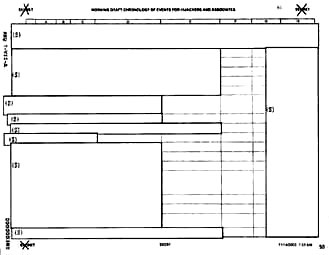
A completely redacted
page from the FBI’s timeline.
[Source: Public domain]
Unfortunately, much of the FBI timeline is
heavily censored, with entire pages sometimes being completely redacted.
But
from what we do know, this timeline indicates that many questions remain
about the hijackers and the 9/11 attacks. We know that the FBI’s timeline
was available to the 9/11 Commission, so why did the commission fail to
mention any of the information listed above?
It’s interesting to compare the results of the 9/11 Commission with the
9/11
Congressional Inquiry that proceeded it. For instance, while the 9/11
Commission downplayed any possible ties between the hijackers and the Saudi
government, the 9/11 Congressional Inquiry wrote an entire chapter on the
topic.
Unfortunately, all 28 pages of that chapter were censored.
But Sen. Bob Graham, co-chair of the inquiry,
later claimed that evidence relating to the two hijackers who lived in San
Diego “presented a compelling case that there was Saudi assistance” to the
9/11 plot. He alleged that Omar al-Bayoumi in fact was a Saudi intelligence
agent.
He also concluded that President Bush
directed the FBI “to restrain and obfuscate” investigations into these ties.
Now, we’re finally beginning to see some of what was in those missing 28
pages.
One anonymous official who has seen the pages claims:
“We’re not talking about rogue elements.
We’re talking about a coordinated network that reaches right from the
hijackers to multiple places in the Saudi government.”
The 9/11 Commission also downplayed the idea
that the hijackers had any assistance in the US. The 9/11 Congressional
Inquiry, by contrast, noted that many people who interacted with the
hijackers in the US, including Omar al-Bayoumi, were
under FBI investigation even before 9/11.
Unfortunately, neither the 9/11 Commission nor the 9/11 Congressional
Inquiry was a complete and unbiased investigation. If this timeline reflects
just some of what only the FBI knew about the hijackers one month after the
attacks, one can only guess at how much more all the US agencies combined
know about the hijackers now.
Why is that information being kept secret?
FBI document:

-
FBI Hijackers Timeline, cover sheet,
pages 1-105
-
FBI Hijackers Timeline, pages
106-210
-
FBI Hijackers Timeline, pages
211-297
|







